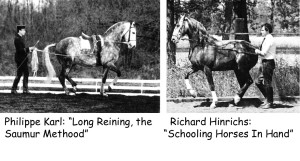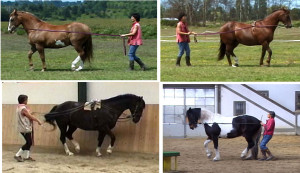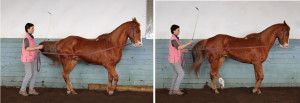Long-reining – Part 12
|
|
Arbeit am langen Zügel – Teil 12
|
- In the last part we cheered up our horses by teaching them to feel grand doing the Spanish Step on the long-reins, because the half-pass (which we will continuously be practising, of course) was such a hard morsel to chew. The Spanish Step proved to be a very useful exercise, because it is highly motivating to the horses, since for them it is a playful gesture and therefore FUN! Apart from cheering them up, it also teaches the horses to make themselves light on the forehand – and therefore to take on more weight with the hind.
The piaffe:
- This, of course, is the epitome of collection! This exercise is a move, where the horse “trots” with expression and suspension, but without forward movement.
|
|
- Im letzten Blog hatten wir unsere Pferde mit dem spanischen Schritt am langen Zügel ermuntert, da die Traversale (die wir natürlich weiterüben!) so ein harter Brocken war. Dazu war der spanische Schritt eine gute Übung, da er auf Pferde so motivierend wirkt, da er für sie eine Spielgeste und daher amüsant ist! Abgesehen von der Aufheiterung hat es die Pferde auch gelehrt sich auf der Vorhand leicht zu machen – und damit auf der Hinterhand mehr Gewicht aufzunehmen.
Die Piaffe:
- Die ist natürlich der Inbegriff der Versammlung! In dieser Aufgabe „trabt“ das Pferd mit Ausdruck und Energie, aber ohne Vorwärtsbewegung.
|
 Demonstrated by the masters!
Von den Meistern vorgeführt!
|
Very useful prep-Games:
- In Blog 06 of this series we learned how to slow our horse down, while in trot, and how to explain to him the concept of collection. You have hopefully tried out the “Step-Let Game” in my book “From Leading to Liberty” on page 244 (and demonstrated in the film “Playing with Horses”). Also the game „Backwards with lowered croup“ (game 62, p. 242), where the horse learned to tilt his pelvis and lower his croup for collection.
- You begin teaching your horse the piaffe on the long reins with the afore mentioned games of “Steplets”, “Bw…” and frequent transitions from backing up to trot. In Blog 06 I introduced you to the game of “Cradle in the long-reins”, where we achieve piaffe-like steps by gradually shortening his steps through frequent changes in direction. The horse learned to understand the touching aid on the dock of his tail as a request to pinch his tail and tilt his pelvis under – thus collecting and slowing down at the same time.
- Here you have established the cooperation between trainer and pupil with voice commands, whip signs and your body language in general. While training for the Spanish Step you have also taught your horse nice shoulder freedom – and with all this preparation and the absence of the added weight of a rider, it will now be easier for your horse to learn the balance, which is needed for the execution of an expressive piaffe.
|
|
Sehr nützliche Vorbereitung:
- Im Blog 06 dieser Serie haben wir gelernt, wie man sein Pferd im Trab langsamer macht und ihm das Konzept der Versammlung nahe bringt. Ich hoffe, Sie haben das „Schrittchen Spiel“ (in meinem Buch “From Leading to Liberty” auf Seite 244 und im Film “Playing with Horses”- auch deutsch! – demonstriert) und „Rückwärts mit gesenkter Kruppe“ (Spiel 62 auf Seite 242) ausprobiert, wo das Pferd lernt sein Becken zu kippen und seine Kruppe zur Versammlung abzusenken.
- Man beginnt beim Lehren der Piaffe am langen Zügel damit, daß man die schon erwähnten Spiele „Schrittchen“ „Rückwärts..“ und häufige Übergänge zwischen Rückwärtsrichten und Antraben abfragt. Im Blog 06 hatte ich Sie in das Spiel „Wiege“ eingeführt, wo wir schon piaffe-ähnliche Tritte durch graduelles Kürzen der Schritte und dauernde Richtungsänderungen erreicht hatten. Das Pferd hat gelernt die Touchierhilfe auf der Schweifrübe als Aufforderung seinen Schweif einzuklemmen und das Becken abzukippen zu erkennen und gleichzeitig mit dem Versammeln auch langsamer zu werden.
- Hier hat man schon die Kooperation zwischen Trainer und Schüler mit Stimme, Gertenzeichen und genereller Körpersprache hergestellt. Beim Üben des spanischen Schritts haben Sie dem Pferd auch die Schulterfreiheit beigebracht – und mit all dieser Vorbereitung und dem Fehlen des Reitergewichtes wird es dem Pferd nun leichter fallen, die Balance zu erlernen, die es für eine ausdrucksvolle Piaffe braucht.
|
 Frequent transitions from backing up to trot will help the horse to slow down and collect.
Viele Übergänge zwischen Rückwärtsrichten und Antraben machen das Pferd langsamer und versammelter. |
Back-up and trot transitions:
- While the horse reins back, he transfers his weight onto his hind legs, but already “bunches up” his body in anticipation of the take-off in trot. His start into trot will also be controlled, as soon as he has understood that another back-up will follow – so he never gets into a “running mode”. All this he has learned in the previous games! In both the rein-back as well as the trot, his legs move diagonally. The horse advances less and less in both directions, but with an increased amount of energy. Less movement forward and back – more “bounce” upward! This automatically leads to piaffe-like steps!
|
|
Übergänge Rückwärtsrichten und Antraben:
- Wenn das Pferd rückwärts geht, schiebt es sein Gewicht auf die Hinterhand, aber gleichzeitig wird es hier schon seinen Körper in Erwartung des Antrabens „zusammen schieben“. Sein Antraben wird ebenfalls kontrolliert ablaufen, da es ja schon gleich ein weiteres Rückwärtsrichten erwartet – so kommt das Pferd nie in „Renn-Laune“. All dies hat es ja in den vorherigen Spielen schon verstanden! In beidem, dem Rückwärtsrichten sowie im Trab, bewegen sich seine Beine diagonal. Das Pferd kommt in beiden Richtungen immer weniger vom Fleck, aber mit erhöhter Energie. Weniger vor und rück – mehr Schwung nach oben! Das führt ganz automatisch zu Piaffe-ähnlichen Tritten!
|
 All our horses learned the concept of tilting the pelvis and collecting on the long reins.
Alle unsere Pferde haben das Konzept des Kruppe Absenkens und der Versammlung am langen Zügel gelernt.
|
- Work along the wall or fence at the start, which makes it easier for your horse to retain straightness. At the start, stand on the inside and within his field of vision to give him more security when applying your aids, especially with the whip. Later you can take up the position behind your horse again.
|
|
- Fangen Sie entlang der Wand oder dem Zaun an, damit das Pferd leichter gerade bleibt. Gehen Sie anfangs an seiner Innenseite und in seinem Blickfeld, um ihm mehr Vertrauen in Ihre Hilfen, vor allem die Touchierhilfen, zu geben. Später fällt man dann wieder in die Position hinter dem Pferd zurück.
|
 Although Beau`s mouth is never totally relaxed, his bearing is proud and he piaffes light in my hands.
Obwohl Beau`s Maul nie ganz entspannt sein wird, piaffiert er stolz und leicht in meiner Hand. |
Canter on the long-reins:
- If you want your horse to canter on the long reins without pulling you into a water-skiing position or making you run like an Olympian sprinter, then you better practice collection first!
- When we first started to work the horse on the long reins in trot (Blog 05 of this series), we mentioned that a horse cannot think, when he is in the „running mode”. When a horse is presented with a new request, he often becomes nervous – and in a flight animal obviously this triggers “running”! So, if your training is to be efficient, you must first establish calm and trust. Each time, after you demand something from your partner, you must check whether he is still relaxed – do NOT pressure him! Each time, he cramps up and runs, you must take one or several steps back on the scale of learning and re-establish the motivation! I do this by interspersing the beloved games of Spanish Step and piaffe.
Synchronize well!
- While practising exercises in trot you learned to adapt your strides to the required tempo of the gait without having to run – and to do this smoothly during transitions without surprising your horse by sudden hectic starts and stops. All this, including keeping the soft contact on the reins at all times will now become even more challenging in transitions to canter!
|
|
Galopp am langen Zügel:
- Wenn Sie Ihr Pferd am langen Zügel galoppieren lassen wollen, ohne wie ein Wasserskiläufer hinterhergezogen zu werden oder wie ein olympischer Sprinter zu rennen, dann machen Sie lieber erst solche Versammlungsaufgaben!
- Als wir die erste Trabarbeit am langen Zügel versuchten (Blog 05 dieser Serie), haben wir erwähnt, daß ein Pferd nicht denken kann, wenn es im „Renn-Modus“ ist. Wenn man ein Pferd mit einer neuen Aufgabe konfrontiert, wird es oft nervös – was in einem Fluchttier sofort „Gerenne“ auslöst! Wenn Ihr Training also effizient sein soll, müssen Sie zuerst Ruhe und Vertrauen herstellen. Jedes Mal, wenn Sie von Ihrem Partner etwas verlangen, müssen Sie einen oder mehrere Schritte auf der Lernskala zurück nehmen und die Motivation wieder herstellen! Ich mache das, indem ich die geliebten Spiele des spanischen Schrittes und der Piaffe einfüge.
Sychronisieren Sie sich!
- Schon beim Üben des ersten Trabs haben Sie gelernt, Ihre Schritte dem Tempo des Pferdes anzupassen ohne rennen zu müssen – und dies während der Übergänge flüssig und ohne hektische Spurts und Abbremsungen zu tun. All das, inklusive der Beibehaltung von weichem Zügelkontakt, wird nun mit Übergängen in den Gallop noch ein bißchen schwieriger.
|
 Beau canters slow enough so I can walk along – though with big strides. Do NOT pull !
Beau galoppiert langsam genug, so daß ich – zwar mit langen Schritten – nebenher gehen kann. NICHT ziehen ! |
- Here again, Beau was a very difficult case. I told you in the very beginning how traumatised he was – and we know that a horse will never forget those bad experiences. As soon as he feels the slightest pressure on the bit, his mouth is wide open in protest, so I had to be particularly careful with a soft hand. Also it is difficult for Beau, with his long and ruined back, to collect properly: He has a sunken back and fused bones in the lumbar vertebrae and sacrum, which aggravate the matter. And of course his age and arthritis do not help… I even suspect that sometimes he quite enjoys, when I really have to RUN to keep up with him (he LOVES playing tag!) – so let me tell you: slowing him down to a canter on the long reins was quite a task!
- Ask for only a few canter strides at the beginning. Work on the circle and walk on his inside – start with the side which is easier for your horse. I park my outside hand on the croup at first, as this helps me to keep a steady contact. Give your voice command for canter and a slight half halt – and start marching energetically right away!! Do NOT yank your horse in the mouth, because you are not synchronized or can’t walk along fast enough! Remember not to run – that just makes everyone hectic and defeats the purpose of the exercise. When things speed up – stop! Insert a pause, a piaffe, or Spanish Step. Re-establish calm. Catch your breath… Praise every effort of your horse to remain slow – even if he has “understood”, this is difficult for him!!
- This is as far as Beau and I have advanced on the long reins to this point, so I will stop the series of this Blog here. As soon as we can perform canter pirouettes on the long reins, I will inform you of it with glorious pictures… we hope! And we continue to train – some long rein stuff each week, but not often enough to take the fun out of it.
- When does your horse stop to have fun?? Can you recognize the first signs? To understand what your horse says to you about this, read on in the series about knowledgeable playing, where we are dealing with this topic right now.
Read on! |
|
- Hier war Beau wieder ein besonders schwieriger Fall. Ich hatte anfangs erwähnt wie traumatisiert er ist – und wir wissen ja, daß ein Pferd schlechte Erfahrungen niemals vergißt. Sobald er den leichtesten Druck auf die Laden fühlt, reißt er sein Maul in Protest weit auf, und ich muß immer mit einer weichen Hand besonders vorsichtig sein. Auch ist es für Beau mit einem so langen und beschädigten Rücken schwer sich zu versammeln: er hat einen deutlichen Senkrücken mit Verknöcherungen in der Wirbelsäule, die die Sache noch erschweren. Und sein Alter und die Arthritis machen auch nichts leichter… Ich denke sogar, daß er es ganz knorke findet, wenn ich richtig wetzen muß, um nicht hintan zu bleiben (er liebt es ja „Fangis“ zu spielen!!) – also kann ich wahrheitsgemäß sagen, daß es nicht leicht war, das Tempo im Galopp am langen Zügel zu drosseln!
- Verlangen Sie anfangs immer nur ein paar Galoppsprünge. Arbeiten Sie auf dem Zirkel und gehen an seiner Innenseite – beginnen Sie auf der Hand, auf der es dem Pferd leichter fällt. Ich parke meine äußere Hand zuerst auf der Kruppe, was mir hilft einen gleichmäßigen Zügelkontakt zu halten. Geben Sie Ihre Stimmhilfe für Galopp und eine halbe Parade – und marschieren Sie sofort energisch los!! Reißen Sie nicht Ihr Pferd im Maul, weil Sie nicht sychronisiert sind oder nicht schnell genug mitlaufen können! Aber rennen Sie nicht – das macht bloß alle hektisch und dann verfehlt man den ganzen Zweck der Sache.
- Wenn es zu schnell wird – anhalten! Machen Sie eine Pause, oder fügen Sie den spanischen Schritt oder die Piaffe ein. Stellen Sie die Ruhe wieder her. Verschnaufen Sie… Loben Sie jedes Anzeichen, daß Ihr Pferd sich bemüht langsam zu bleiben – selbst wenn es schon verstanden hat, was Sie wollen, so ist dies schwierig für es!!
- So weit sind Beau und ich bisher am langen Zügel gekommen, so daß ich die Serie hier beenden werde. Sobald wir Galopp-Pirouetten am langen Zügel vorführen können, werde ich Ihnen das sicher mit gloriosen Fotos mitteilen… so hoffen wir! Und wir üben weiter – ein bißchen langer Zügel jede Woche, aber nie so viel, daß der Spaß dabei verloren geht.
- Und wann verliert das Pferd den Spaß daran?? Können sie die frühen Anzeichen erkennen? Zum Verständnis dessen, was Ihr Pferd Ihnen darüber mitteilen will, lesen Sie die Blogs über fachmännisches Spielen weiter, wo wir gerade bei diesem Thema sind.
Lesen Sie weiter! |






